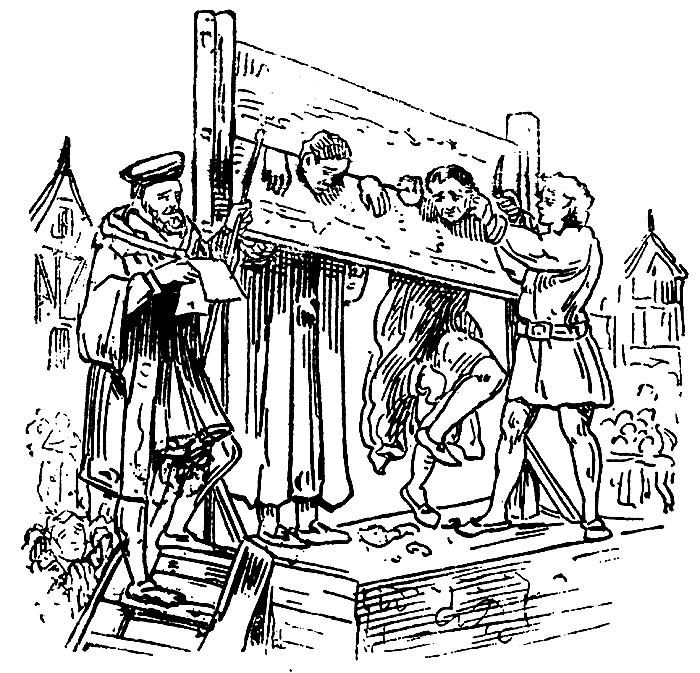 The pillory tended to be a
shorter term punishment, a few hours, not usually more than a day. But the
victim’s position, bent over and unable to move his or her head, was considerably
more uncomfortable than the stocks.
The pillory tended to be a
shorter term punishment, a few hours, not usually more than a day. But the
victim’s position, bent over and unable to move his or her head, was considerably
more uncomfortable than the stocks.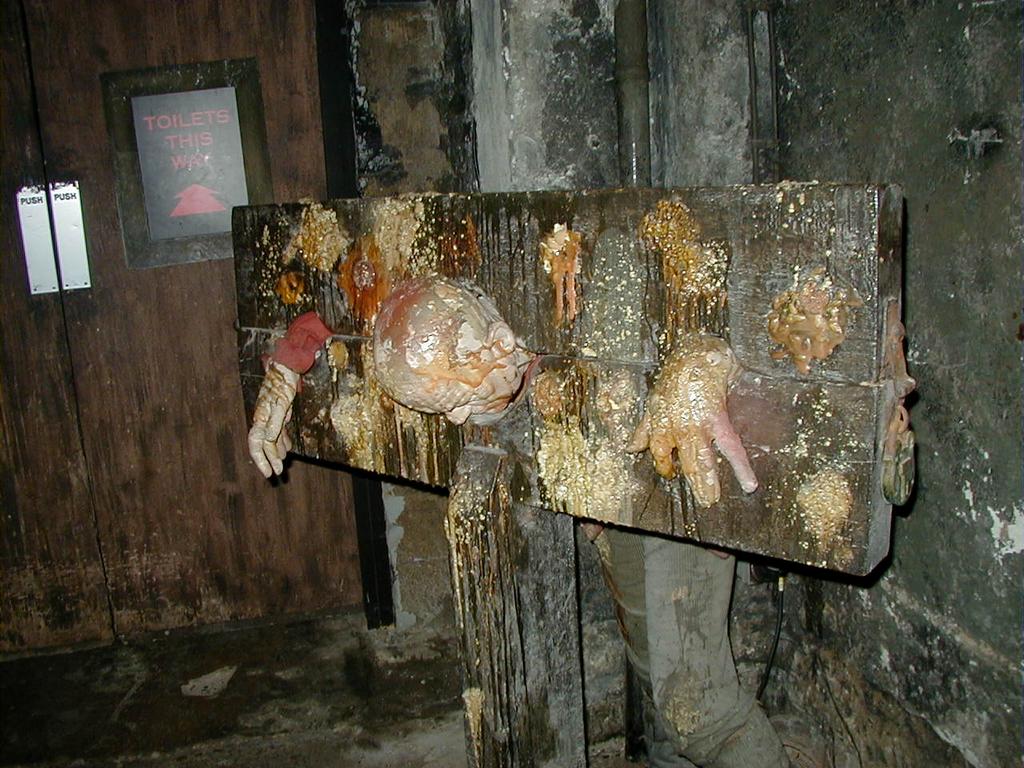 Although the concept of public punishment may now seem
strange, even barbaric, it was the accepted norm until the 19th century. It is
only in recent times that prison has been used as a punishment. Before the 19th
century, jails were usually only places to hold people prior to their trial or
punishment.
Although the concept of public punishment may now seem
strange, even barbaric, it was the accepted norm until the 19th century. It is
only in recent times that prison has been used as a punishment. Before the 19th
century, jails were usually only places to hold people prior to their trial or
punishment.
Public humiliation was a major part of punishment in stocks and pillories. These
would always be sited in the most public place available, for example the market
square or village green. In small communities, those being punished would be well
known to everyone else, thereby increasing their shame.
Audience participation was a key element. The helpless victim
would usually be subjected to a barrage of mockery and abuse,
and pelted with any missiles which came to hand. These could
range from rotten fruit and vegetables, mud, excrement, dead
rats, even stones. This was most effective in the pillory, where
the occupant was unable to move his or her head.
The physical discomfort of being confined for long periods in stocks or
pillories should not be discounted. People could be left in the stocks
for days, even weeks, in all weather. Being stuck in the same position would
become very uncomfortable after only a few hours.
 The pillory tended to be a
shorter term punishment, a few hours, not usually more than a day. But the
victim’s position, bent over and unable to move his or her head, was considerably
more uncomfortable than the stocks.
The pillory tended to be a
shorter term punishment, a few hours, not usually more than a day. But the
victim’s position, bent over and unable to move his or her head, was considerably
more uncomfortable than the stocks.
As an additional punishment, people in the pillory sometimes had their ears nailed to the boards. Not only was this painful in itself, but the victim’s head was rendered completely immobile. Ears could be torn off by the victim’s futile efforts to dodge missiles hurled by the crowd. If the victim’s ears were still attached to his or her head on completion of the sentence, they would be cut off before the pillory was opened.
As an alternative (or in addition to) ear cropping, people in the pillory could be branded on the face. The nose could also be slit, or the tongue bored through with a red hot iron.
In 1633, the author William Prynne was sentenced to life imprisonment and to stand in the pillory for publishing a pamphlet which had libelled the Queen. While in the pillory Prynne had his ears cut off, his nose slit, and his books were burned in front of him. A bystander later noted that they burned huge volumes under Prynne’s nose, which almost suffocated him. Prynne subsequently had his ears sewed back on, a most unusual occurrence.
While in prison, Prynne published another pamphlet in 1637 which displeased the authorities. Back in the pillory, the unfortunate Prynne had the initials S.L. (Seditious Libel) branded on both his cheeks. He also lost his ears again, this time permanently.
Some drawings of Prynne in the pillory:
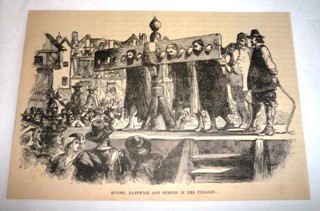
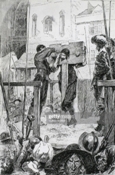
On the 28 June 1800 Mr Savill was put in the pillory at Dover. In his pamphlet, Mr Savill states that the pillory was:
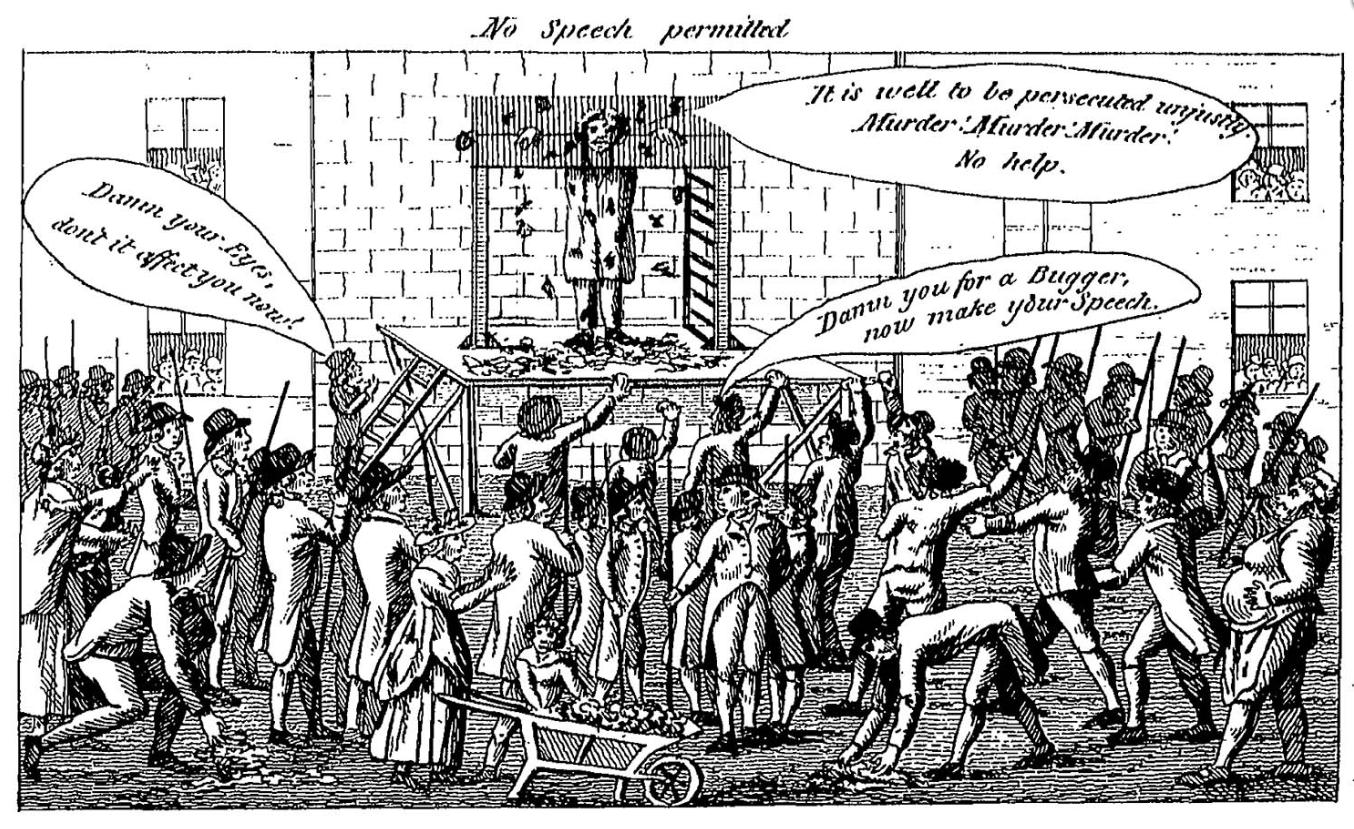 "...fixed up against the side of a building, facing the spectators (supposed to be between three and four thousand), and could not move round in the manner pillories commonly do. I was pelted at in a most shameful manner, and afterwards was informed that Mantell [Mayor of Dover] and King [Deputy Mayor] stood and laughed at the sight. I had no other reason but to believe that Mayor and King were determined that I should be murdered, if they could have done it genteelly, and afterwards brought it in accidental, having upwards of forty constables under a kind cloak of deception. About eight or ten of the ignorant seafaring, and blackguard ruffians, who knew not what they were about, were admitted into the circle, close to the pillory, to pelt me with stones and all manner of filth; and one of the villains even came up and took the filth from under my feet several times, without any interruption by the magistrates or constables, when they might have been prevented with ease. I was used in such a manner, that I expected nothing but death; many of the spectators thinking the same, cried out open shame, and said that I should be a murdered man. One man, to a certainty, fainted away at the sight; others said it was worse than murder, and if the corporation wished to murder me, why did they not blow my brains out at once. My face and head were cut in a most shocking manner. The blood flow'd from my head and temples as though I had been stuck with a knife, through which I was quite blind of one eye for several days, and my friends who saw me did not expect my recovery. I cannot express bad enough the cruelty I experienced..."
"...fixed up against the side of a building, facing the spectators (supposed to be between three and four thousand), and could not move round in the manner pillories commonly do. I was pelted at in a most shameful manner, and afterwards was informed that Mantell [Mayor of Dover] and King [Deputy Mayor] stood and laughed at the sight. I had no other reason but to believe that Mayor and King were determined that I should be murdered, if they could have done it genteelly, and afterwards brought it in accidental, having upwards of forty constables under a kind cloak of deception. About eight or ten of the ignorant seafaring, and blackguard ruffians, who knew not what they were about, were admitted into the circle, close to the pillory, to pelt me with stones and all manner of filth; and one of the villains even came up and took the filth from under my feet several times, without any interruption by the magistrates or constables, when they might have been prevented with ease. I was used in such a manner, that I expected nothing but death; many of the spectators thinking the same, cried out open shame, and said that I should be a murdered man. One man, to a certainty, fainted away at the sight; others said it was worse than murder, and if the corporation wished to murder me, why did they not blow my brains out at once. My face and head were cut in a most shocking manner. The blood flow'd from my head and temples as though I had been stuck with a knife, through which I was quite blind of one eye for several days, and my friends who saw me did not expect my recovery. I cannot express bad enough the cruelty I experienced..."
[from "The Case and Trial of Mr Savill, Dover Corporation Laws Made known to the Lovers of Justice", printed by A. Young, London, 1800]
This case does not appear to have been reported in any local or national newspapers, so we only have Mr Savill’s version of events. Nevertheless it is extremely rare to have an account written by anyone who had actually been pilloried.
